Analysis of Innovation Barriers at MatchBox Architects (MBA)
VerifiedAdded on 2020/11/23
|14
|4416
|489
Report
AI Summary
This report analyzes the innovation barriers faced by MatchBox Architects (MBA), a firm specializing in architectural design. It identifies key challenges such as organizational culture, climate, structure, and size, and how these factors impede innovation and creativity within the company. The report utilizes various models, including the KEYS survey and Woodman model, to understand these barriers. It examines specific problems like over-budgeted projects, communication issues, and lack of client trust. The report also discusses Agile and Scrum project management methodologies as potential solutions and emphasizes the importance of employee motivation, risk-taking, and a supportive work environment to foster innovation. The analysis covers the impact of individual, group, and organizational characteristics on innovation, highlighting the need for changes in policies and working styles to promote a more innovative culture. The report aims to provide insights into overcoming these challenges and improving the firm's performance and client satisfaction.

Live Project
Paraphrase This Document
Need a fresh take? Get an instant paraphrase of this document with our AI Paraphraser

Table of Contents
INTRODUCTION...........................................................................................................................1
MAIN BODY...................................................................................................................................2
BARRIERS TO IMPLEMENTING INNOVATION......................................................................3
ORGANISATIONAL CULTURE..............................................................................................3
ORGANISATIONAL CLIMATE..............................................................................................3
ORGANISATIONAL STRUCTURE ........................................................................................4
ORGANISATIONAL SIZE........................................................................................................5
CONCLUSIONS............................................................................................................................11
RECOMMENDATIONS...............................................................................................................12
REFERENCES..............................................................................................................................13
INTRODUCTION...........................................................................................................................1
MAIN BODY...................................................................................................................................2
BARRIERS TO IMPLEMENTING INNOVATION......................................................................3
ORGANISATIONAL CULTURE..............................................................................................3
ORGANISATIONAL CLIMATE..............................................................................................3
ORGANISATIONAL STRUCTURE ........................................................................................4
ORGANISATIONAL SIZE........................................................................................................5
CONCLUSIONS............................................................................................................................11
RECOMMENDATIONS...............................................................................................................12
REFERENCES..............................................................................................................................13

INTRODUCTION
Innovation is a popular concept in the present scenario which emphasizes on solving
existing and real problems existing along with value creation (Albors-Garrigos and et. al., 2013).
Creativity is act to think, imagine about new idea of services which can help a business sustain in
the market. Innovation and creativity are used interchangeably but there is difference among
them. Creativity is about framing fresh idea which is not present in market, while innovation
focuses on making alteration to existing products and services which can be helpful in creating
value for the business. These days consumer want latest services with some modifications.
Hence promoters of business has to come with new and innovative ideas which helps to make
business successful and growth prospects can be increased. Innovation can be about introducing
new technology, enhancing product line, innovative method of production, etc. But there is
requirement of proper analysis of market and related factors. This helps to promote business idea
in industry.
These days there is requirement of innovation to make good and long term relations with
customers. As compared to initial days, there is difference in demand of consumers, so it is
responsibility of managers to come with different and effective options. There are different
factors which affects innovation and creativity in organisation. It is essential to analyse them, and
actions has to be taken in order to resolve them (Chesbrough, H., 2010). Manager of organisation
has to take actions through which they can overcome them.
This report is based on MatchBox Architects (MBA) which deals in providing well
designed buildings and space. This organisation was established in 2009. They believe in making
team of person having different perception so that innovation and creativity can be availed in
context of an organisation. They set some goals and targets of team mates is to attain it which
bring perfection in services. MatchBox Architects (MBA) has vision to earn good reputation in
industry by providing good services. There are some values of MatchBox Architects (MBA)
such as client's are their priority, make strategies for safeguarding future, etc. They use RIBA
work stages in order to complete project. There is requirement of innovation by MatchBox
Architects (MBA) in order to work according to market trends. As there is difference in demand
of consumer, so this must be considered in order to get positive results.
AIMS AND OBJECTIVES
1
Innovation is a popular concept in the present scenario which emphasizes on solving
existing and real problems existing along with value creation (Albors-Garrigos and et. al., 2013).
Creativity is act to think, imagine about new idea of services which can help a business sustain in
the market. Innovation and creativity are used interchangeably but there is difference among
them. Creativity is about framing fresh idea which is not present in market, while innovation
focuses on making alteration to existing products and services which can be helpful in creating
value for the business. These days consumer want latest services with some modifications.
Hence promoters of business has to come with new and innovative ideas which helps to make
business successful and growth prospects can be increased. Innovation can be about introducing
new technology, enhancing product line, innovative method of production, etc. But there is
requirement of proper analysis of market and related factors. This helps to promote business idea
in industry.
These days there is requirement of innovation to make good and long term relations with
customers. As compared to initial days, there is difference in demand of consumers, so it is
responsibility of managers to come with different and effective options. There are different
factors which affects innovation and creativity in organisation. It is essential to analyse them, and
actions has to be taken in order to resolve them (Chesbrough, H., 2010). Manager of organisation
has to take actions through which they can overcome them.
This report is based on MatchBox Architects (MBA) which deals in providing well
designed buildings and space. This organisation was established in 2009. They believe in making
team of person having different perception so that innovation and creativity can be availed in
context of an organisation. They set some goals and targets of team mates is to attain it which
bring perfection in services. MatchBox Architects (MBA) has vision to earn good reputation in
industry by providing good services. There are some values of MatchBox Architects (MBA)
such as client's are their priority, make strategies for safeguarding future, etc. They use RIBA
work stages in order to complete project. There is requirement of innovation by MatchBox
Architects (MBA) in order to work according to market trends. As there is difference in demand
of consumer, so this must be considered in order to get positive results.
AIMS AND OBJECTIVES
1
⊘ This is a preview!⊘
Do you want full access?
Subscribe today to unlock all pages.

Trusted by 1+ million students worldwide
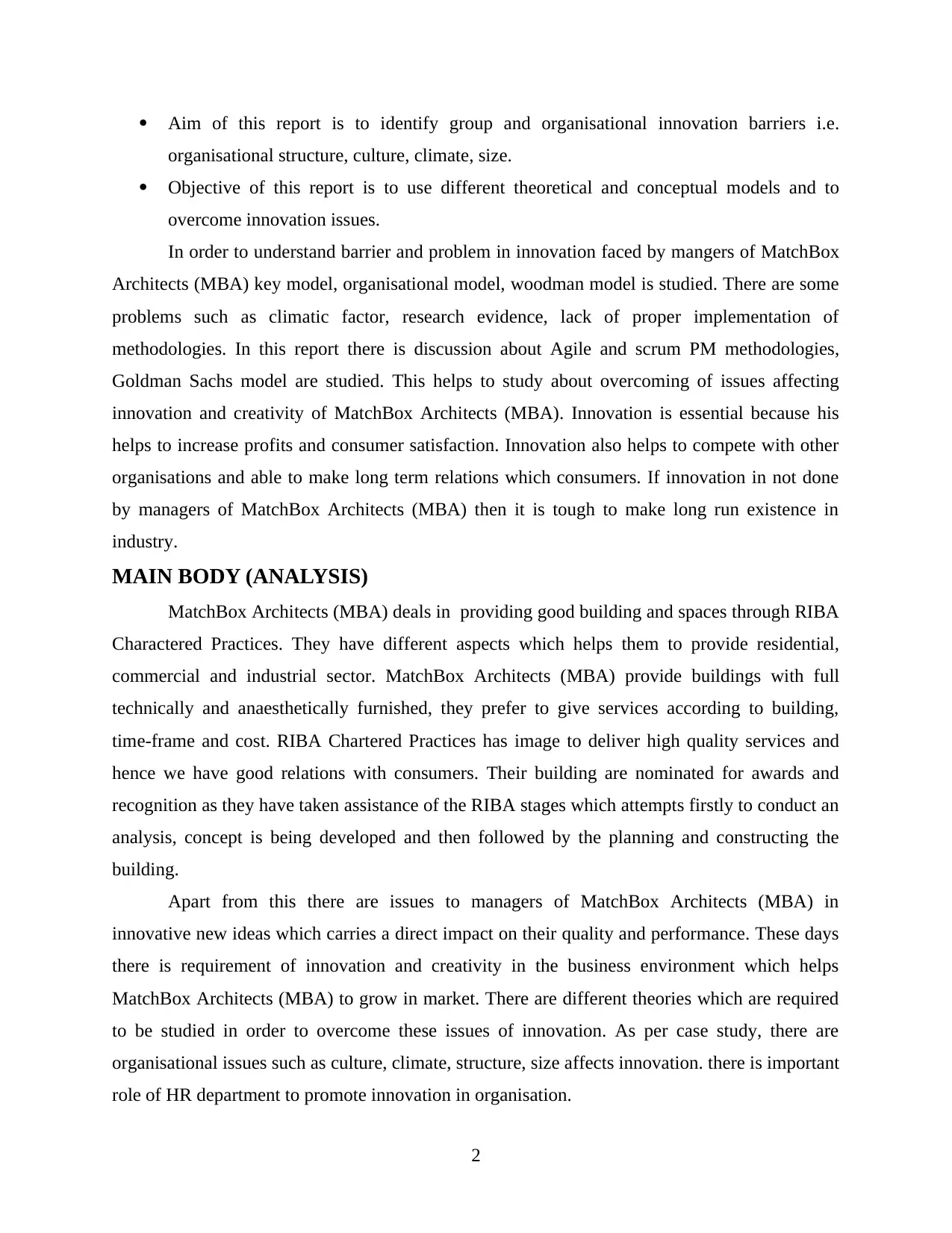
Aim of this report is to identify group and organisational innovation barriers i.e.
organisational structure, culture, climate, size.
Objective of this report is to use different theoretical and conceptual models and to
overcome innovation issues.
In order to understand barrier and problem in innovation faced by mangers of MatchBox
Architects (MBA) key model, organisational model, woodman model is studied. There are some
problems such as climatic factor, research evidence, lack of proper implementation of
methodologies. In this report there is discussion about Agile and scrum PM methodologies,
Goldman Sachs model are studied. This helps to study about overcoming of issues affecting
innovation and creativity of MatchBox Architects (MBA). Innovation is essential because his
helps to increase profits and consumer satisfaction. Innovation also helps to compete with other
organisations and able to make long term relations which consumers. If innovation in not done
by managers of MatchBox Architects (MBA) then it is tough to make long run existence in
industry.
MAIN BODY (ANALYSIS)
MatchBox Architects (MBA) deals in providing good building and spaces through RIBA
Charactered Practices. They have different aspects which helps them to provide residential,
commercial and industrial sector. MatchBox Architects (MBA) provide buildings with full
technically and anaesthetically furnished, they prefer to give services according to building,
time-frame and cost. RIBA Chartered Practices has image to deliver high quality services and
hence we have good relations with consumers. Their building are nominated for awards and
recognition as they have taken assistance of the RIBA stages which attempts firstly to conduct an
analysis, concept is being developed and then followed by the planning and constructing the
building.
Apart from this there are issues to managers of MatchBox Architects (MBA) in
innovative new ideas which carries a direct impact on their quality and performance. These days
there is requirement of innovation and creativity in the business environment which helps
MatchBox Architects (MBA) to grow in market. There are different theories which are required
to be studied in order to overcome these issues of innovation. As per case study, there are
organisational issues such as culture, climate, structure, size affects innovation. there is important
role of HR department to promote innovation in organisation.
2
organisational structure, culture, climate, size.
Objective of this report is to use different theoretical and conceptual models and to
overcome innovation issues.
In order to understand barrier and problem in innovation faced by mangers of MatchBox
Architects (MBA) key model, organisational model, woodman model is studied. There are some
problems such as climatic factor, research evidence, lack of proper implementation of
methodologies. In this report there is discussion about Agile and scrum PM methodologies,
Goldman Sachs model are studied. This helps to study about overcoming of issues affecting
innovation and creativity of MatchBox Architects (MBA). Innovation is essential because his
helps to increase profits and consumer satisfaction. Innovation also helps to compete with other
organisations and able to make long term relations which consumers. If innovation in not done
by managers of MatchBox Architects (MBA) then it is tough to make long run existence in
industry.
MAIN BODY (ANALYSIS)
MatchBox Architects (MBA) deals in providing good building and spaces through RIBA
Charactered Practices. They have different aspects which helps them to provide residential,
commercial and industrial sector. MatchBox Architects (MBA) provide buildings with full
technically and anaesthetically furnished, they prefer to give services according to building,
time-frame and cost. RIBA Chartered Practices has image to deliver high quality services and
hence we have good relations with consumers. Their building are nominated for awards and
recognition as they have taken assistance of the RIBA stages which attempts firstly to conduct an
analysis, concept is being developed and then followed by the planning and constructing the
building.
Apart from this there are issues to managers of MatchBox Architects (MBA) in
innovative new ideas which carries a direct impact on their quality and performance. These days
there is requirement of innovation and creativity in the business environment which helps
MatchBox Architects (MBA) to grow in market. There are different theories which are required
to be studied in order to overcome these issues of innovation. As per case study, there are
organisational issues such as culture, climate, structure, size affects innovation. there is important
role of HR department to promote innovation in organisation.
2
Paraphrase This Document
Need a fresh take? Get an instant paraphrase of this document with our AI Paraphraser
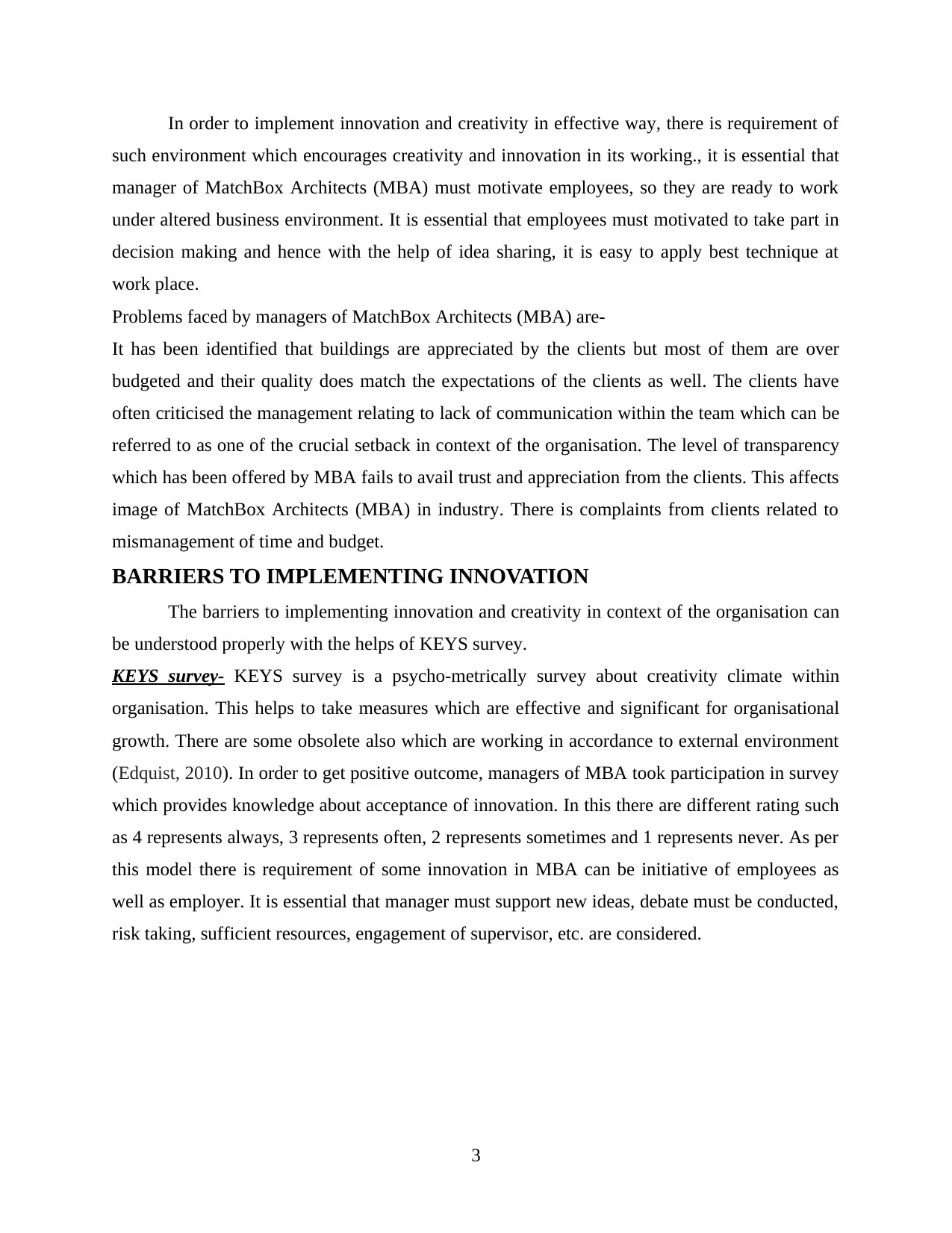
In order to implement innovation and creativity in effective way, there is requirement of
such environment which encourages creativity and innovation in its working., it is essential that
manager of MatchBox Architects (MBA) must motivate employees, so they are ready to work
under altered business environment. It is essential that employees must motivated to take part in
decision making and hence with the help of idea sharing, it is easy to apply best technique at
work place.
Problems faced by managers of MatchBox Architects (MBA) are-
It has been identified that buildings are appreciated by the clients but most of them are over
budgeted and their quality does match the expectations of the clients as well. The clients have
often criticised the management relating to lack of communication within the team which can be
referred to as one of the crucial setback in context of the organisation. The level of transparency
which has been offered by MBA fails to avail trust and appreciation from the clients. This affects
image of MatchBox Architects (MBA) in industry. There is complaints from clients related to
mismanagement of time and budget.
BARRIERS TO IMPLEMENTING INNOVATION
The barriers to implementing innovation and creativity in context of the organisation can
be understood properly with the helps of KEYS survey.
KEYS survey- KEYS survey is a psycho-metrically survey about creativity climate within
organisation. This helps to take measures which are effective and significant for organisational
growth. There are some obsolete also which are working in accordance to external environment
(Edquist, 2010). In order to get positive outcome, managers of MBA took participation in survey
which provides knowledge about acceptance of innovation. In this there are different rating such
as 4 represents always, 3 represents often, 2 represents sometimes and 1 represents never. As per
this model there is requirement of some innovation in MBA can be initiative of employees as
well as employer. It is essential that manager must support new ideas, debate must be conducted,
risk taking, sufficient resources, engagement of supervisor, etc. are considered.
3
such environment which encourages creativity and innovation in its working., it is essential that
manager of MatchBox Architects (MBA) must motivate employees, so they are ready to work
under altered business environment. It is essential that employees must motivated to take part in
decision making and hence with the help of idea sharing, it is easy to apply best technique at
work place.
Problems faced by managers of MatchBox Architects (MBA) are-
It has been identified that buildings are appreciated by the clients but most of them are over
budgeted and their quality does match the expectations of the clients as well. The clients have
often criticised the management relating to lack of communication within the team which can be
referred to as one of the crucial setback in context of the organisation. The level of transparency
which has been offered by MBA fails to avail trust and appreciation from the clients. This affects
image of MatchBox Architects (MBA) in industry. There is complaints from clients related to
mismanagement of time and budget.
BARRIERS TO IMPLEMENTING INNOVATION
The barriers to implementing innovation and creativity in context of the organisation can
be understood properly with the helps of KEYS survey.
KEYS survey- KEYS survey is a psycho-metrically survey about creativity climate within
organisation. This helps to take measures which are effective and significant for organisational
growth. There are some obsolete also which are working in accordance to external environment
(Edquist, 2010). In order to get positive outcome, managers of MBA took participation in survey
which provides knowledge about acceptance of innovation. In this there are different rating such
as 4 represents always, 3 represents often, 2 represents sometimes and 1 represents never. As per
this model there is requirement of some innovation in MBA can be initiative of employees as
well as employer. It is essential that manager must support new ideas, debate must be conducted,
risk taking, sufficient resources, engagement of supervisor, etc. are considered.
3
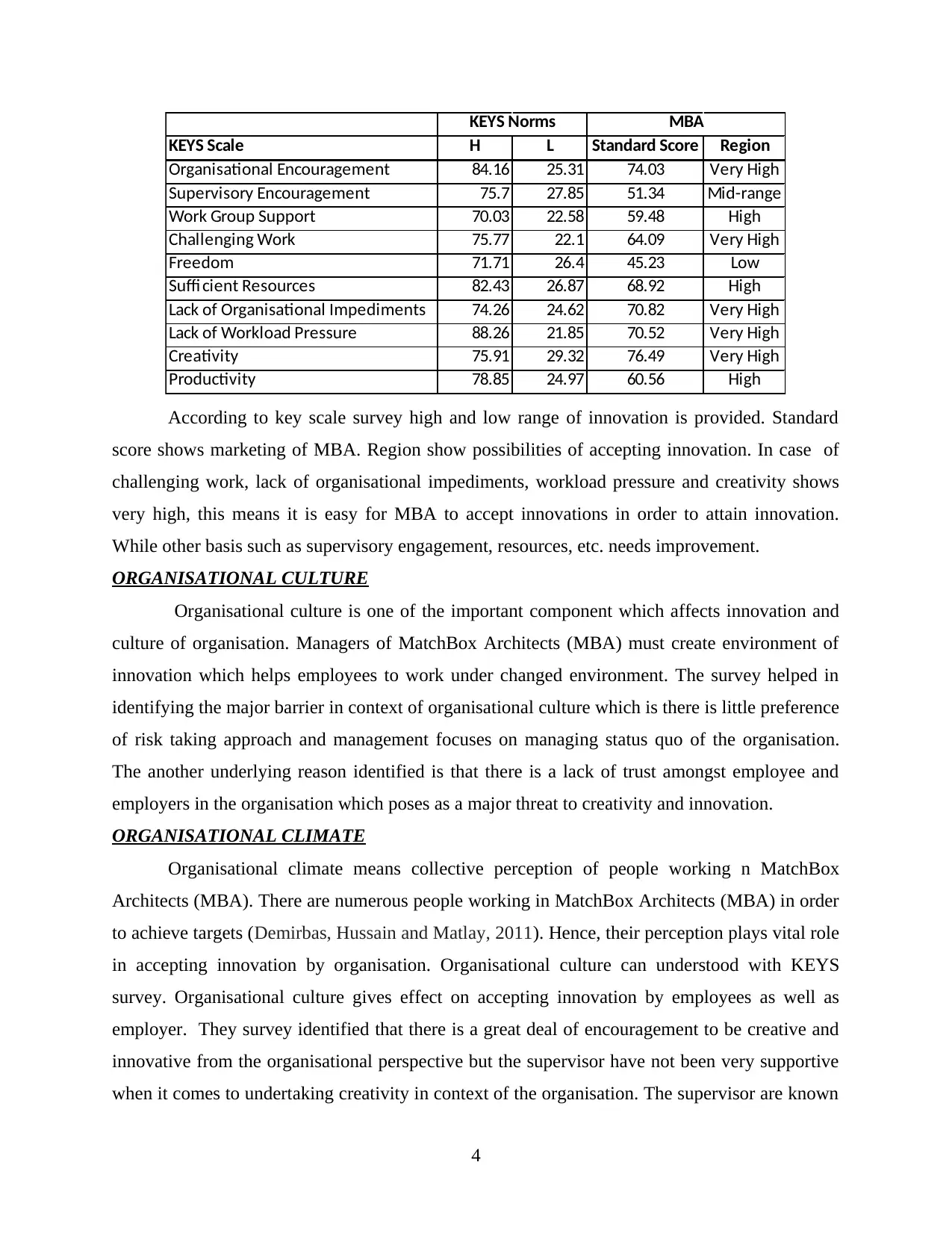
KEYS Scale H L Standard Score Region
Organisational Encouragement 84.16 25.31 74.03 Very High
Supervisory Encouragement 75.7 27.85 51.34 Mid-range
Work Group Support 70.03 22.58 59.48 High
Challenging Work 75.77 22.1 64.09 Very High
Freedom 71.71 26.4 45.23 Low
Suffi cient Resources 82.43 26.87 68.92 High
Lack of Organisational Impediments 74.26 24.62 70.82 Very High
Lack of Workload Pressure 88.26 21.85 70.52 Very High
Creativity 75.91 29.32 76.49 Very High
Productivity 78.85 24.97 60.56 High
KEYS Norms MBA
According to key scale survey high and low range of innovation is provided. Standard
score shows marketing of MBA. Region show possibilities of accepting innovation. In case of
challenging work, lack of organisational impediments, workload pressure and creativity shows
very high, this means it is easy for MBA to accept innovations in order to attain innovation.
While other basis such as supervisory engagement, resources, etc. needs improvement.
ORGANISATIONAL CULTURE
Organisational culture is one of the important component which affects innovation and
culture of organisation. Managers of MatchBox Architects (MBA) must create environment of
innovation which helps employees to work under changed environment. The survey helped in
identifying the major barrier in context of organisational culture which is there is little preference
of risk taking approach and management focuses on managing status quo of the organisation.
The another underlying reason identified is that there is a lack of trust amongst employee and
employers in the organisation which poses as a major threat to creativity and innovation.
ORGANISATIONAL CLIMATE
Organisational climate means collective perception of people working n MatchBox
Architects (MBA). There are numerous people working in MatchBox Architects (MBA) in order
to achieve targets (Demirbas, Hussain and Matlay, 2011). Hence, their perception plays vital role
in accepting innovation by organisation. Organisational culture can understood with KEYS
survey. Organisational culture gives effect on accepting innovation by employees as well as
employer. They survey identified that there is a great deal of encouragement to be creative and
innovative from the organisational perspective but the supervisor have not been very supportive
when it comes to undertaking creativity in context of the organisation. The supervisor are known
4
Organisational Encouragement 84.16 25.31 74.03 Very High
Supervisory Encouragement 75.7 27.85 51.34 Mid-range
Work Group Support 70.03 22.58 59.48 High
Challenging Work 75.77 22.1 64.09 Very High
Freedom 71.71 26.4 45.23 Low
Suffi cient Resources 82.43 26.87 68.92 High
Lack of Organisational Impediments 74.26 24.62 70.82 Very High
Lack of Workload Pressure 88.26 21.85 70.52 Very High
Creativity 75.91 29.32 76.49 Very High
Productivity 78.85 24.97 60.56 High
KEYS Norms MBA
According to key scale survey high and low range of innovation is provided. Standard
score shows marketing of MBA. Region show possibilities of accepting innovation. In case of
challenging work, lack of organisational impediments, workload pressure and creativity shows
very high, this means it is easy for MBA to accept innovations in order to attain innovation.
While other basis such as supervisory engagement, resources, etc. needs improvement.
ORGANISATIONAL CULTURE
Organisational culture is one of the important component which affects innovation and
culture of organisation. Managers of MatchBox Architects (MBA) must create environment of
innovation which helps employees to work under changed environment. The survey helped in
identifying the major barrier in context of organisational culture which is there is little preference
of risk taking approach and management focuses on managing status quo of the organisation.
The another underlying reason identified is that there is a lack of trust amongst employee and
employers in the organisation which poses as a major threat to creativity and innovation.
ORGANISATIONAL CLIMATE
Organisational climate means collective perception of people working n MatchBox
Architects (MBA). There are numerous people working in MatchBox Architects (MBA) in order
to achieve targets (Demirbas, Hussain and Matlay, 2011). Hence, their perception plays vital role
in accepting innovation by organisation. Organisational culture can understood with KEYS
survey. Organisational culture gives effect on accepting innovation by employees as well as
employer. They survey identified that there is a great deal of encouragement to be creative and
innovative from the organisational perspective but the supervisor have not been very supportive
when it comes to undertaking creativity in context of the organisation. The supervisor are known
4
⊘ This is a preview!⊘
Do you want full access?
Subscribe today to unlock all pages.

Trusted by 1+ million students worldwide

to focus on status quo of the organisation which provides them with less scope of improvement
in their existing approaches to performing task. As per survey, it has been identified that
providing liberty to perform in their own manner can be a significant step towards improving
state of creativity and innovation in context of the organisation.
ORGANISATIONAL STRUCTURE
Organisational structure means levels of hierarchy in organisation. There is three levels in
organisation, they are top level, middle level and lower level (Huizingh, 2011). There is
difference in roles and responsibilities, working style hence this affects application of innovation.
In MBA there are various departments working to achieve goals and targets. It is essential that
managers has to be keep eyes on working style so corrective measures can be achieved. In MBA,
departmental head does not take initiate to perform operation in effective and efficient way, so
this affects implementation of innovation in association.
ORGANISATIONAL SIZE
MBA deals in providing residential, industrial, corporate houses. So this affects growth
of organisation through innovation. There are possibilities that due to change in roles and
responsibilities manager has to divide various departments of MBA according to task (Kline and
Rosenberg, 2010). This ease in working and communication is more effective. In case of small
size organisation, innovations are not accepted so frequently because of fear of failure. While in
case of large size organisation there is requirement of proper research and development, which
affects
Agile and Scrum Project Management methodologies
Scrum is method to manage project with the help of Agile. Scrum helps in successful
delivery of software and assist MatchBox Architects (MBA) to work frequently. This technique
helps to guide team in order to get positive outcome. Agile project management framework assist
workers to respond frequently and correct information will be delivered to concern person. This
helps managers of MatchBox Architects (MBA) targets positive outcomes.
The reason for which this approach is being emphasized in context to project
management is that it will be helpful in delivering the project within time and budget specified.
Undertaking of this model will be helpful in business in dealing with their problems of over-
5
in their existing approaches to performing task. As per survey, it has been identified that
providing liberty to perform in their own manner can be a significant step towards improving
state of creativity and innovation in context of the organisation.
ORGANISATIONAL STRUCTURE
Organisational structure means levels of hierarchy in organisation. There is three levels in
organisation, they are top level, middle level and lower level (Huizingh, 2011). There is
difference in roles and responsibilities, working style hence this affects application of innovation.
In MBA there are various departments working to achieve goals and targets. It is essential that
managers has to be keep eyes on working style so corrective measures can be achieved. In MBA,
departmental head does not take initiate to perform operation in effective and efficient way, so
this affects implementation of innovation in association.
ORGANISATIONAL SIZE
MBA deals in providing residential, industrial, corporate houses. So this affects growth
of organisation through innovation. There are possibilities that due to change in roles and
responsibilities manager has to divide various departments of MBA according to task (Kline and
Rosenberg, 2010). This ease in working and communication is more effective. In case of small
size organisation, innovations are not accepted so frequently because of fear of failure. While in
case of large size organisation there is requirement of proper research and development, which
affects
Agile and Scrum Project Management methodologies
Scrum is method to manage project with the help of Agile. Scrum helps in successful
delivery of software and assist MatchBox Architects (MBA) to work frequently. This technique
helps to guide team in order to get positive outcome. Agile project management framework assist
workers to respond frequently and correct information will be delivered to concern person. This
helps managers of MatchBox Architects (MBA) targets positive outcomes.
The reason for which this approach is being emphasized in context to project
management is that it will be helpful in delivering the project within time and budget specified.
Undertaking of this model will be helpful in business in dealing with their problems of over-
5
Paraphrase This Document
Need a fresh take? Get an instant paraphrase of this document with our AI Paraphraser
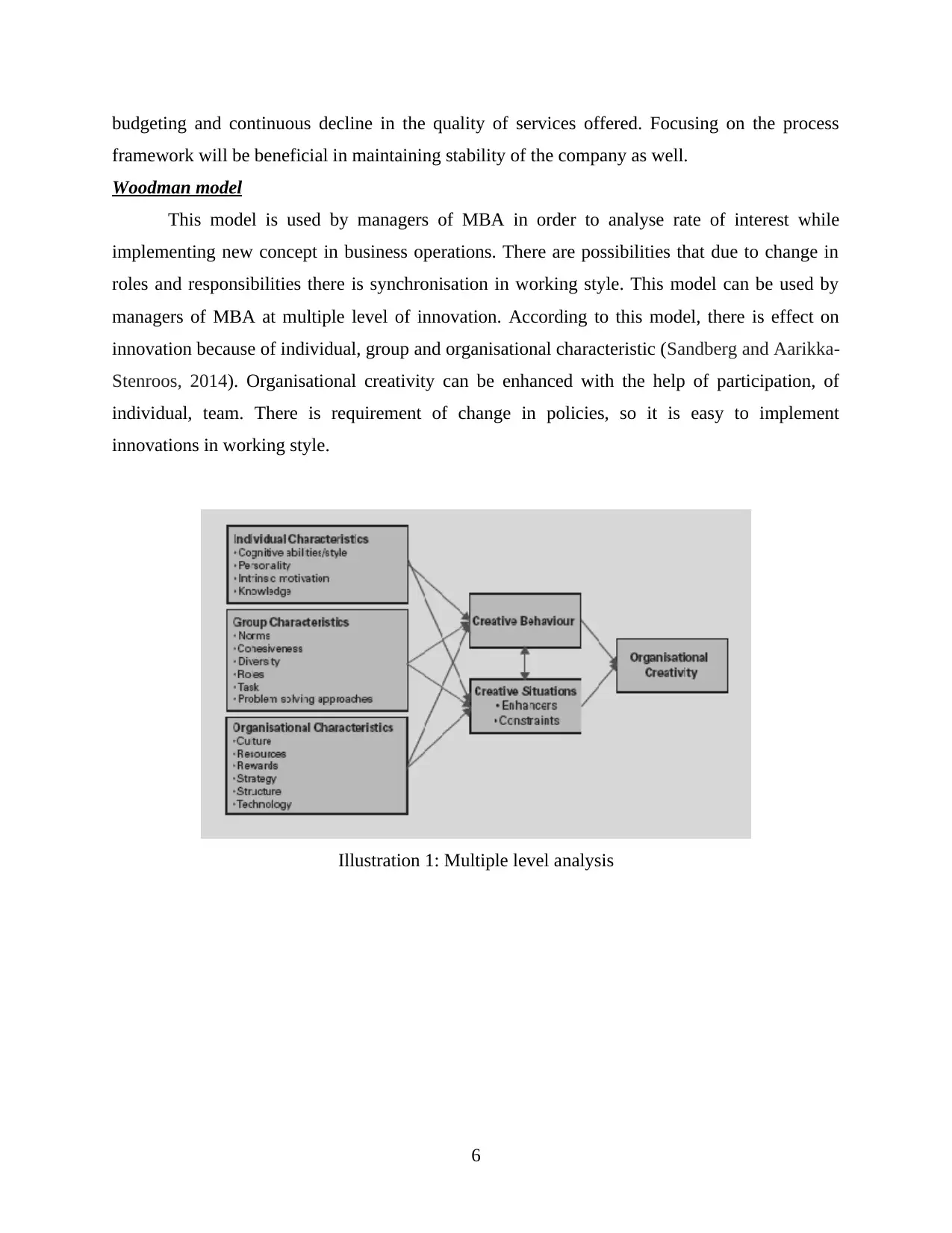
budgeting and continuous decline in the quality of services offered. Focusing on the process
framework will be beneficial in maintaining stability of the company as well.
Woodman model
This model is used by managers of MBA in order to analyse rate of interest while
implementing new concept in business operations. There are possibilities that due to change in
roles and responsibilities there is synchronisation in working style. This model can be used by
managers of MBA at multiple level of innovation. According to this model, there is effect on
innovation because of individual, group and organisational characteristic (Sandberg and Aarikka-
Stenroos, 2014). Organisational creativity can be enhanced with the help of participation, of
individual, team. There is requirement of change in policies, so it is easy to implement
innovations in working style.
6
Illustration 1: Multiple level analysis
framework will be beneficial in maintaining stability of the company as well.
Woodman model
This model is used by managers of MBA in order to analyse rate of interest while
implementing new concept in business operations. There are possibilities that due to change in
roles and responsibilities there is synchronisation in working style. This model can be used by
managers of MBA at multiple level of innovation. According to this model, there is effect on
innovation because of individual, group and organisational characteristic (Sandberg and Aarikka-
Stenroos, 2014). Organisational creativity can be enhanced with the help of participation, of
individual, team. There is requirement of change in policies, so it is easy to implement
innovations in working style.
6
Illustration 1: Multiple level analysis
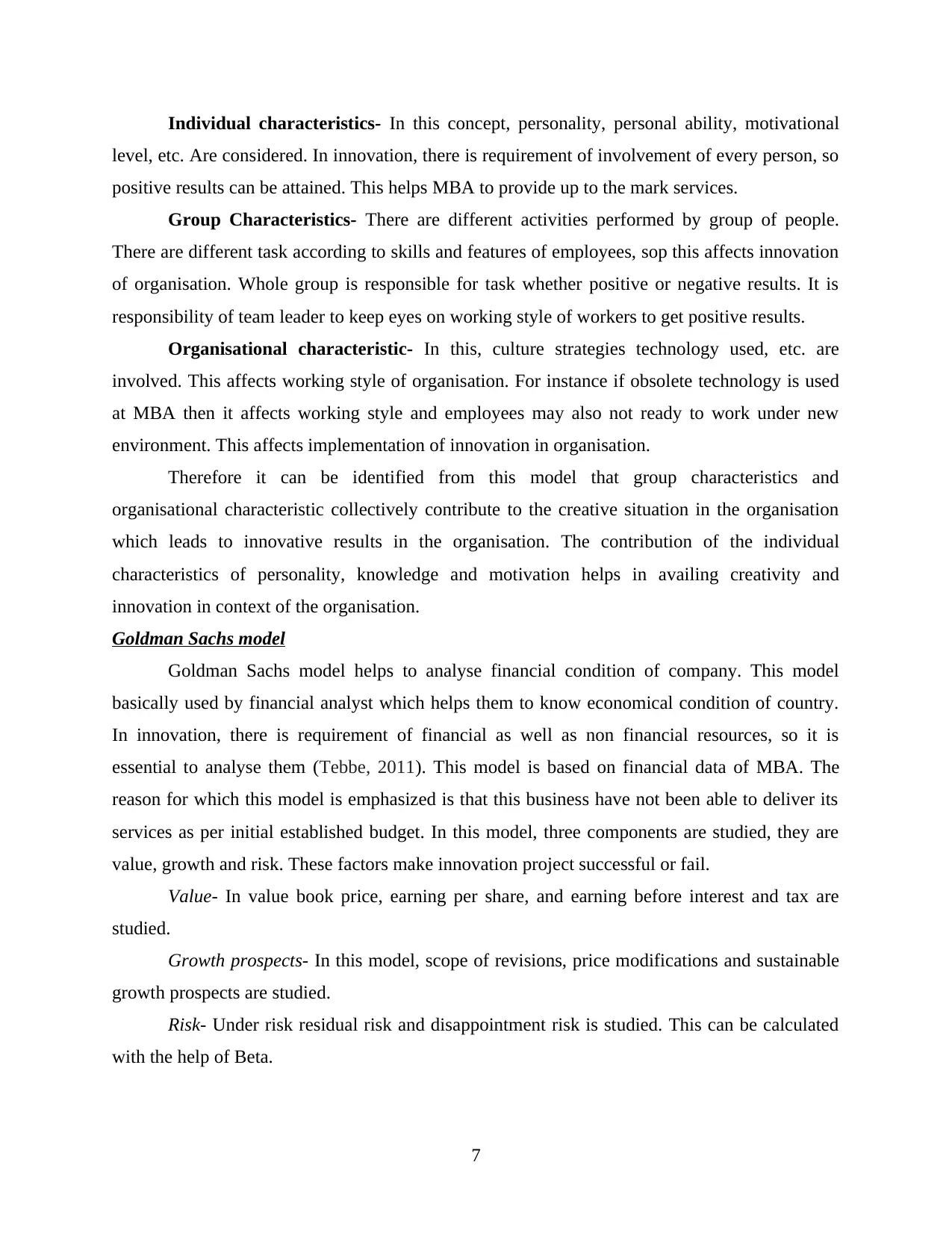
Individual characteristics- In this concept, personality, personal ability, motivational
level, etc. Are considered. In innovation, there is requirement of involvement of every person, so
positive results can be attained. This helps MBA to provide up to the mark services.
Group Characteristics- There are different activities performed by group of people.
There are different task according to skills and features of employees, sop this affects innovation
of organisation. Whole group is responsible for task whether positive or negative results. It is
responsibility of team leader to keep eyes on working style of workers to get positive results.
Organisational characteristic- In this, culture strategies technology used, etc. are
involved. This affects working style of organisation. For instance if obsolete technology is used
at MBA then it affects working style and employees may also not ready to work under new
environment. This affects implementation of innovation in organisation.
Therefore it can be identified from this model that group characteristics and
organisational characteristic collectively contribute to the creative situation in the organisation
which leads to innovative results in the organisation. The contribution of the individual
characteristics of personality, knowledge and motivation helps in availing creativity and
innovation in context of the organisation.
Goldman Sachs model
Goldman Sachs model helps to analyse financial condition of company. This model
basically used by financial analyst which helps them to know economical condition of country.
In innovation, there is requirement of financial as well as non financial resources, so it is
essential to analyse them (Tebbe, 2011). This model is based on financial data of MBA. The
reason for which this model is emphasized is that this business have not been able to deliver its
services as per initial established budget. In this model, three components are studied, they are
value, growth and risk. These factors make innovation project successful or fail.
Value- In value book price, earning per share, and earning before interest and tax are
studied.
Growth prospects- In this model, scope of revisions, price modifications and sustainable
growth prospects are studied.
Risk- Under risk residual risk and disappointment risk is studied. This can be calculated
with the help of Beta.
7
level, etc. Are considered. In innovation, there is requirement of involvement of every person, so
positive results can be attained. This helps MBA to provide up to the mark services.
Group Characteristics- There are different activities performed by group of people.
There are different task according to skills and features of employees, sop this affects innovation
of organisation. Whole group is responsible for task whether positive or negative results. It is
responsibility of team leader to keep eyes on working style of workers to get positive results.
Organisational characteristic- In this, culture strategies technology used, etc. are
involved. This affects working style of organisation. For instance if obsolete technology is used
at MBA then it affects working style and employees may also not ready to work under new
environment. This affects implementation of innovation in organisation.
Therefore it can be identified from this model that group characteristics and
organisational characteristic collectively contribute to the creative situation in the organisation
which leads to innovative results in the organisation. The contribution of the individual
characteristics of personality, knowledge and motivation helps in availing creativity and
innovation in context of the organisation.
Goldman Sachs model
Goldman Sachs model helps to analyse financial condition of company. This model
basically used by financial analyst which helps them to know economical condition of country.
In innovation, there is requirement of financial as well as non financial resources, so it is
essential to analyse them (Tebbe, 2011). This model is based on financial data of MBA. The
reason for which this model is emphasized is that this business have not been able to deliver its
services as per initial established budget. In this model, three components are studied, they are
value, growth and risk. These factors make innovation project successful or fail.
Value- In value book price, earning per share, and earning before interest and tax are
studied.
Growth prospects- In this model, scope of revisions, price modifications and sustainable
growth prospects are studied.
Risk- Under risk residual risk and disappointment risk is studied. This can be calculated
with the help of Beta.
7
⊘ This is a preview!⊘
Do you want full access?
Subscribe today to unlock all pages.

Trusted by 1+ million students worldwide
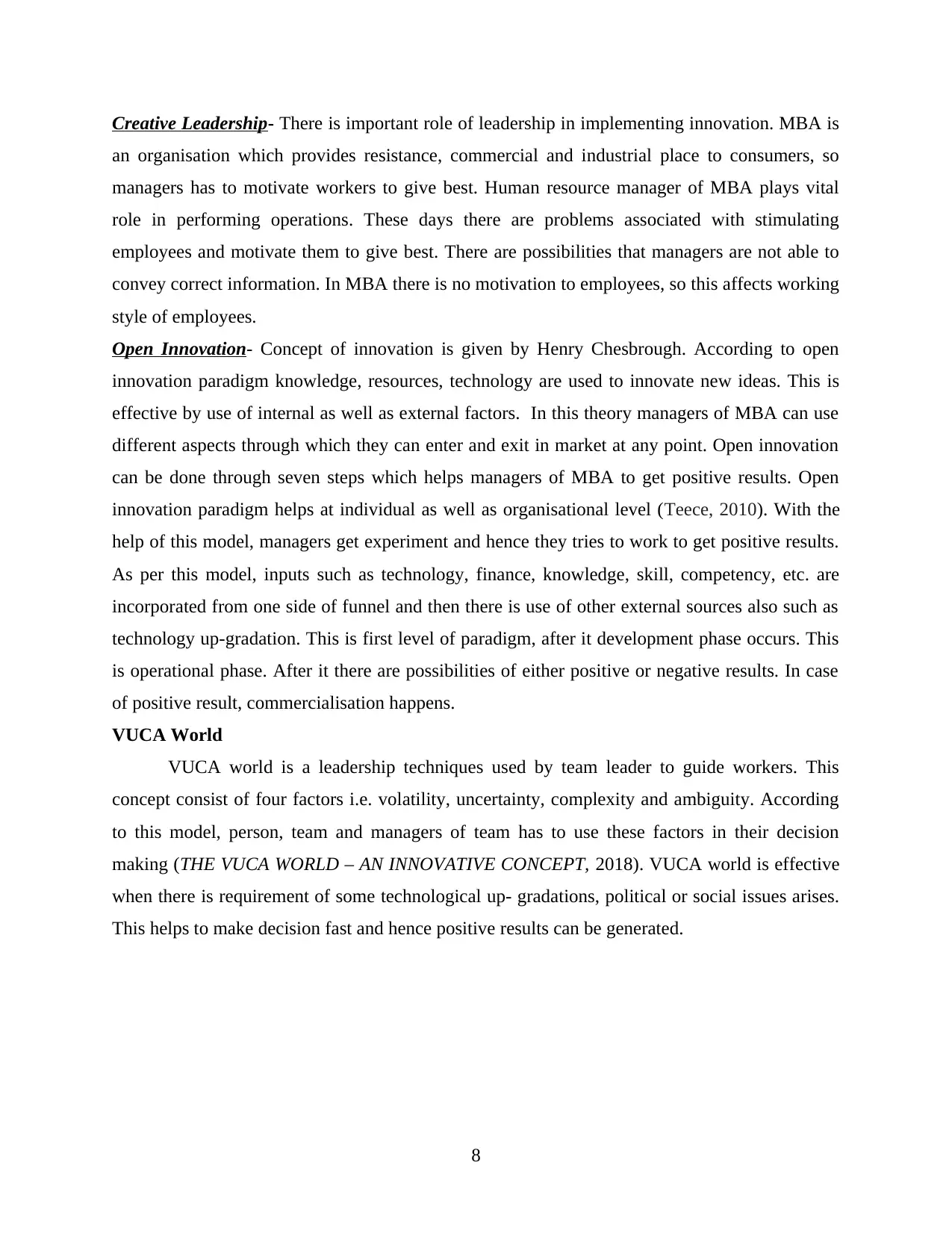
Creative Leadership- There is important role of leadership in implementing innovation. MBA is
an organisation which provides resistance, commercial and industrial place to consumers, so
managers has to motivate workers to give best. Human resource manager of MBA plays vital
role in performing operations. These days there are problems associated with stimulating
employees and motivate them to give best. There are possibilities that managers are not able to
convey correct information. In MBA there is no motivation to employees, so this affects working
style of employees.
Open Innovation- Concept of innovation is given by Henry Chesbrough. According to open
innovation paradigm knowledge, resources, technology are used to innovate new ideas. This is
effective by use of internal as well as external factors. In this theory managers of MBA can use
different aspects through which they can enter and exit in market at any point. Open innovation
can be done through seven steps which helps managers of MBA to get positive results. Open
innovation paradigm helps at individual as well as organisational level (Teece, 2010). With the
help of this model, managers get experiment and hence they tries to work to get positive results.
As per this model, inputs such as technology, finance, knowledge, skill, competency, etc. are
incorporated from one side of funnel and then there is use of other external sources also such as
technology up-gradation. This is first level of paradigm, after it development phase occurs. This
is operational phase. After it there are possibilities of either positive or negative results. In case
of positive result, commercialisation happens.
VUCA World
VUCA world is a leadership techniques used by team leader to guide workers. This
concept consist of four factors i.e. volatility, uncertainty, complexity and ambiguity. According
to this model, person, team and managers of team has to use these factors in their decision
making (THE VUCA WORLD – AN INNOVATIVE CONCEPT, 2018). VUCA world is effective
when there is requirement of some technological up- gradations, political or social issues arises.
This helps to make decision fast and hence positive results can be generated.
8
an organisation which provides resistance, commercial and industrial place to consumers, so
managers has to motivate workers to give best. Human resource manager of MBA plays vital
role in performing operations. These days there are problems associated with stimulating
employees and motivate them to give best. There are possibilities that managers are not able to
convey correct information. In MBA there is no motivation to employees, so this affects working
style of employees.
Open Innovation- Concept of innovation is given by Henry Chesbrough. According to open
innovation paradigm knowledge, resources, technology are used to innovate new ideas. This is
effective by use of internal as well as external factors. In this theory managers of MBA can use
different aspects through which they can enter and exit in market at any point. Open innovation
can be done through seven steps which helps managers of MBA to get positive results. Open
innovation paradigm helps at individual as well as organisational level (Teece, 2010). With the
help of this model, managers get experiment and hence they tries to work to get positive results.
As per this model, inputs such as technology, finance, knowledge, skill, competency, etc. are
incorporated from one side of funnel and then there is use of other external sources also such as
technology up-gradation. This is first level of paradigm, after it development phase occurs. This
is operational phase. After it there are possibilities of either positive or negative results. In case
of positive result, commercialisation happens.
VUCA World
VUCA world is a leadership techniques used by team leader to guide workers. This
concept consist of four factors i.e. volatility, uncertainty, complexity and ambiguity. According
to this model, person, team and managers of team has to use these factors in their decision
making (THE VUCA WORLD – AN INNOVATIVE CONCEPT, 2018). VUCA world is effective
when there is requirement of some technological up- gradations, political or social issues arises.
This helps to make decision fast and hence positive results can be generated.
8
Paraphrase This Document
Need a fresh take? Get an instant paraphrase of this document with our AI Paraphraser
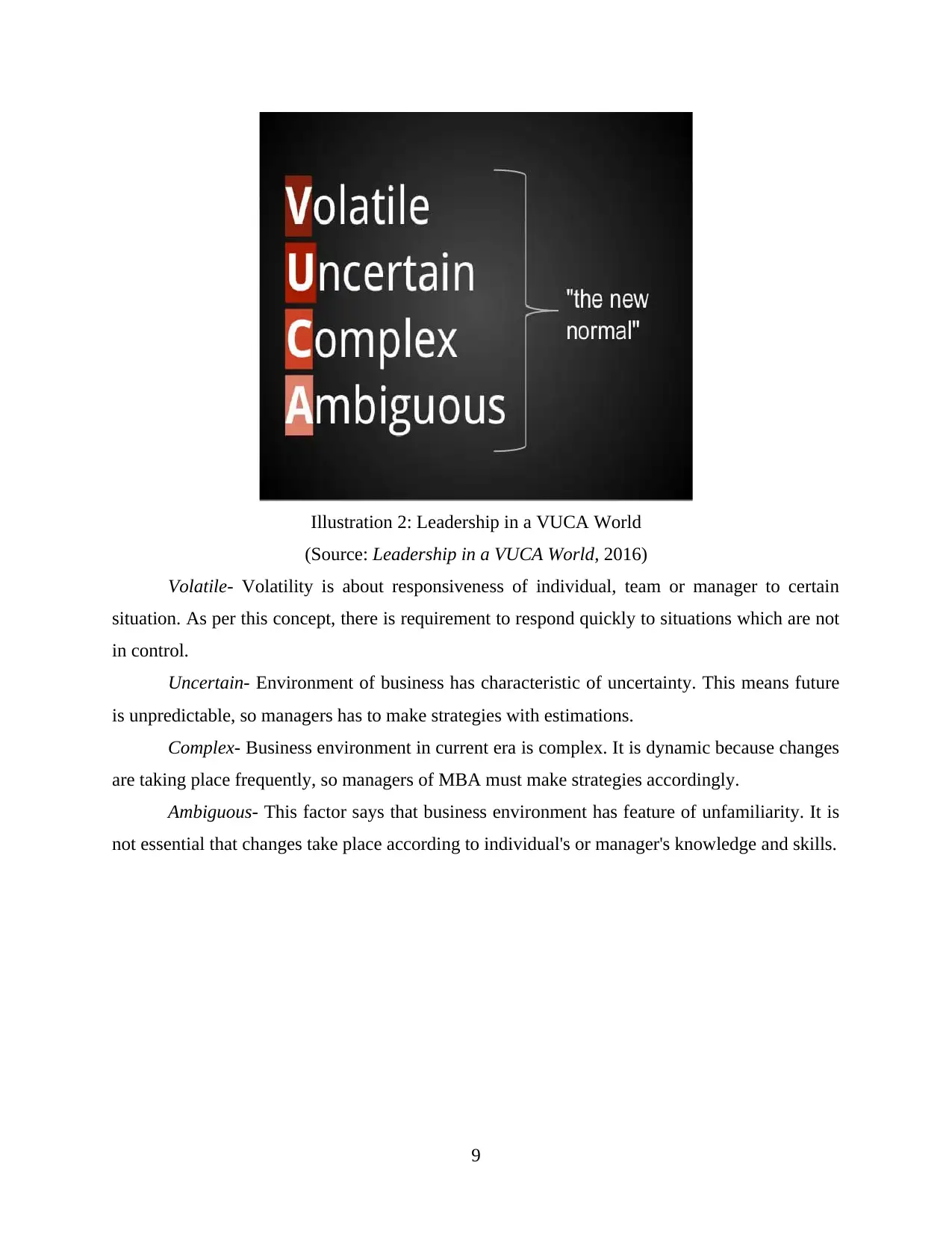
(Source: Leadership in a VUCA World, 2016)
Volatile- Volatility is about responsiveness of individual, team or manager to certain
situation. As per this concept, there is requirement to respond quickly to situations which are not
in control.
Uncertain- Environment of business has characteristic of uncertainty. This means future
is unpredictable, so managers has to make strategies with estimations.
Complex- Business environment in current era is complex. It is dynamic because changes
are taking place frequently, so managers of MBA must make strategies accordingly.
Ambiguous- This factor says that business environment has feature of unfamiliarity. It is
not essential that changes take place according to individual's or manager's knowledge and skills.
9
Illustration 2: Leadership in a VUCA World
Volatile- Volatility is about responsiveness of individual, team or manager to certain
situation. As per this concept, there is requirement to respond quickly to situations which are not
in control.
Uncertain- Environment of business has characteristic of uncertainty. This means future
is unpredictable, so managers has to make strategies with estimations.
Complex- Business environment in current era is complex. It is dynamic because changes
are taking place frequently, so managers of MBA must make strategies accordingly.
Ambiguous- This factor says that business environment has feature of unfamiliarity. It is
not essential that changes take place according to individual's or manager's knowledge and skills.
9
Illustration 2: Leadership in a VUCA World
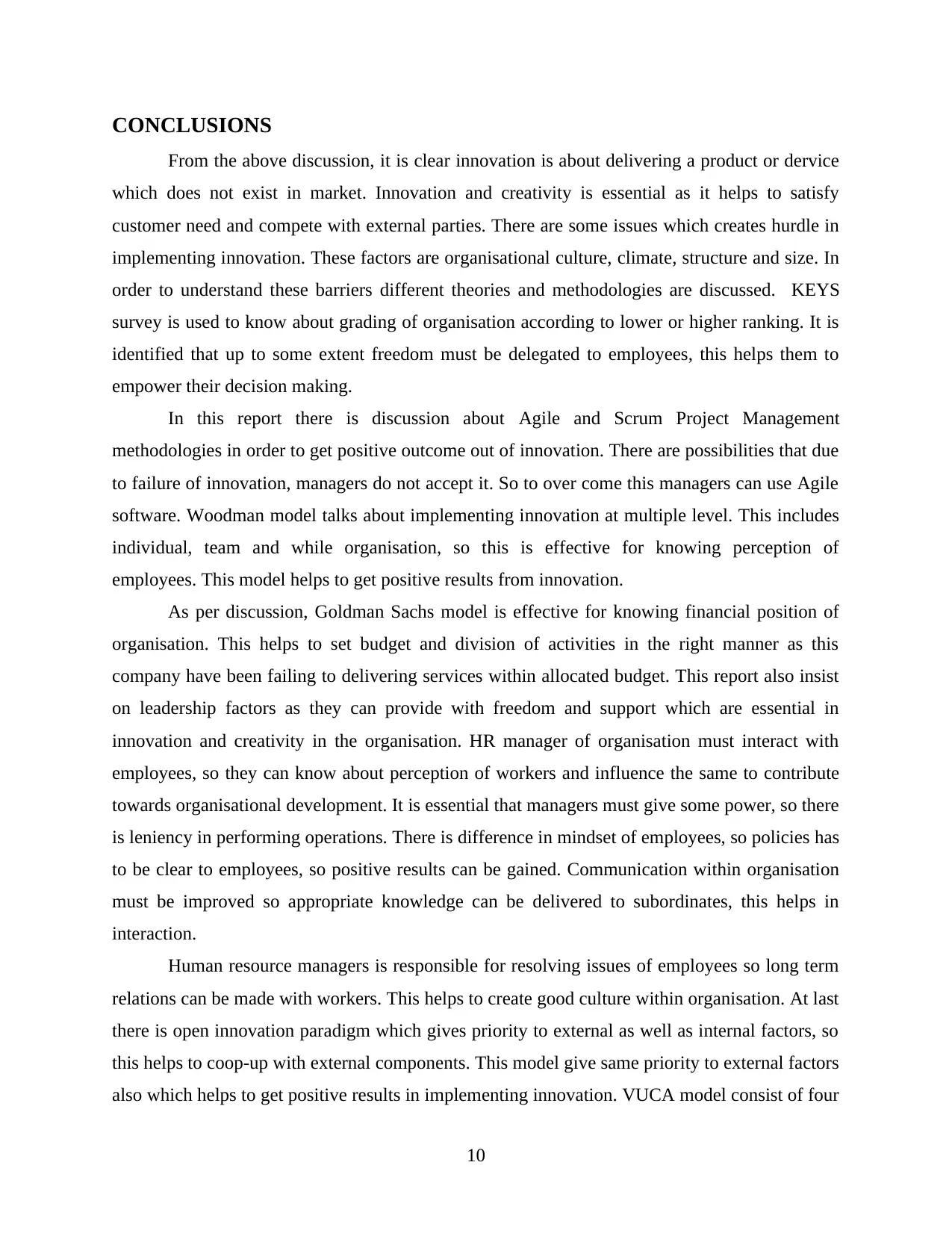
CONCLUSIONS
From the above discussion, it is clear innovation is about delivering a product or dervice
which does not exist in market. Innovation and creativity is essential as it helps to satisfy
customer need and compete with external parties. There are some issues which creates hurdle in
implementing innovation. These factors are organisational culture, climate, structure and size. In
order to understand these barriers different theories and methodologies are discussed. KEYS
survey is used to know about grading of organisation according to lower or higher ranking. It is
identified that up to some extent freedom must be delegated to employees, this helps them to
empower their decision making.
In this report there is discussion about Agile and Scrum Project Management
methodologies in order to get positive outcome out of innovation. There are possibilities that due
to failure of innovation, managers do not accept it. So to over come this managers can use Agile
software. Woodman model talks about implementing innovation at multiple level. This includes
individual, team and while organisation, so this is effective for knowing perception of
employees. This model helps to get positive results from innovation.
As per discussion, Goldman Sachs model is effective for knowing financial position of
organisation. This helps to set budget and division of activities in the right manner as this
company have been failing to delivering services within allocated budget. This report also insist
on leadership factors as they can provide with freedom and support which are essential in
innovation and creativity in the organisation. HR manager of organisation must interact with
employees, so they can know about perception of workers and influence the same to contribute
towards organisational development. It is essential that managers must give some power, so there
is leniency in performing operations. There is difference in mindset of employees, so policies has
to be clear to employees, so positive results can be gained. Communication within organisation
must be improved so appropriate knowledge can be delivered to subordinates, this helps in
interaction.
Human resource managers is responsible for resolving issues of employees so long term
relations can be made with workers. This helps to create good culture within organisation. At last
there is open innovation paradigm which gives priority to external as well as internal factors, so
this helps to coop-up with external components. This model give same priority to external factors
also which helps to get positive results in implementing innovation. VUCA model consist of four
10
From the above discussion, it is clear innovation is about delivering a product or dervice
which does not exist in market. Innovation and creativity is essential as it helps to satisfy
customer need and compete with external parties. There are some issues which creates hurdle in
implementing innovation. These factors are organisational culture, climate, structure and size. In
order to understand these barriers different theories and methodologies are discussed. KEYS
survey is used to know about grading of organisation according to lower or higher ranking. It is
identified that up to some extent freedom must be delegated to employees, this helps them to
empower their decision making.
In this report there is discussion about Agile and Scrum Project Management
methodologies in order to get positive outcome out of innovation. There are possibilities that due
to failure of innovation, managers do not accept it. So to over come this managers can use Agile
software. Woodman model talks about implementing innovation at multiple level. This includes
individual, team and while organisation, so this is effective for knowing perception of
employees. This model helps to get positive results from innovation.
As per discussion, Goldman Sachs model is effective for knowing financial position of
organisation. This helps to set budget and division of activities in the right manner as this
company have been failing to delivering services within allocated budget. This report also insist
on leadership factors as they can provide with freedom and support which are essential in
innovation and creativity in the organisation. HR manager of organisation must interact with
employees, so they can know about perception of workers and influence the same to contribute
towards organisational development. It is essential that managers must give some power, so there
is leniency in performing operations. There is difference in mindset of employees, so policies has
to be clear to employees, so positive results can be gained. Communication within organisation
must be improved so appropriate knowledge can be delivered to subordinates, this helps in
interaction.
Human resource managers is responsible for resolving issues of employees so long term
relations can be made with workers. This helps to create good culture within organisation. At last
there is open innovation paradigm which gives priority to external as well as internal factors, so
this helps to coop-up with external components. This model give same priority to external factors
also which helps to get positive results in implementing innovation. VUCA model consist of four
10
⊘ This is a preview!⊘
Do you want full access?
Subscribe today to unlock all pages.

Trusted by 1+ million students worldwide
1 out of 14
Related Documents
Your All-in-One AI-Powered Toolkit for Academic Success.
+13062052269
info@desklib.com
Available 24*7 on WhatsApp / Email
![[object Object]](/_next/static/media/star-bottom.7253800d.svg)
Unlock your academic potential
Copyright © 2020–2025 A2Z Services. All Rights Reserved. Developed and managed by ZUCOL.





